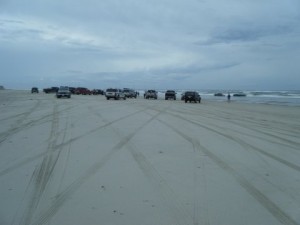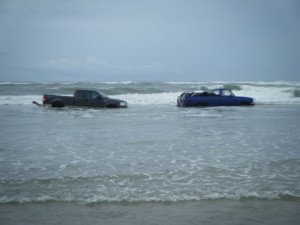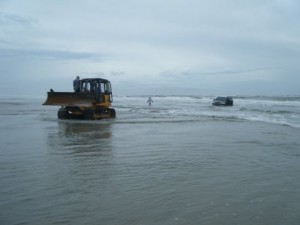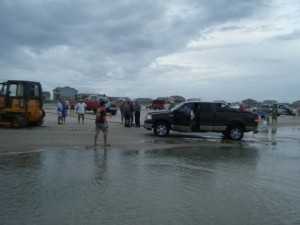How To: Drivin’ the Beach (inspired by actual events). By Dr. Bogus
 If you are a staunch surf fisherman like myself, access to the good spots, jetties, inlets, bars, sloughs and the like, and mobility to get from one to the other, are high on the list for a successful catching, not just fishing trip, to the beach. Here are some totally BOGUS tips to help the sand-bound fisherman return home with both their vehicle and pride intact.
If you are a staunch surf fisherman like myself, access to the good spots, jetties, inlets, bars, sloughs and the like, and mobility to get from one to the other, are high on the list for a successful catching, not just fishing trip, to the beach. Here are some totally BOGUS tips to help the sand-bound fisherman return home with both their vehicle and pride intact.
Things to know BEFORE you go:
First there is the checklist of things to keep on board, and you better check it twice: tire pressure gauge, tide table, tow chain, rope or strap, a thick wooden board and shovel and repeat after me “NO beach toys”. And, do you have a cell phone?? Is the battery charged?
I know it seems basic, but please make sure you are in 4 x 4 mode, BEFORE you go over the ramp onto the beach! People forget all the time and you can easily tell the forgetful when their vehicle has just gotten onto the beach, just over the ramp, where some of the softest sand usually is, and already has one set of wheels planted squarely in the quicksand. That baffled look on the face of the driver is also a dead give-a-way. It’s so easy, just remember get into four-wheel mode BEFORE you go. By the way, have you ever forgotten to put the plug in your boat, and wondered why you were sinking as you left the dock? No, of course not, not me either!
Again, BEFORE you proceed over the entrance ramp, lower your tire pressure to around 20-psig (15-25) and remember to repressurize after leaving the beach. It’s a safety thing. These days there are inexpensive tire deflators that automatically deflate to a set tire pressure, Tire Buddies, Oasis Trailhead Tire Deflators are some of them. Lowering the tire pressure increases the area of the tire that is in contact with the sand and will allow the vehicle to ride on top of the sand, where you want to be, rather than sinking in up to your hubcaps.
 One of the things that I have on the checklist was a tide table. If possible, plan you tides, low/outgoing tide is best. Know thy tide, plan ahead and move up on the incoming tide before you and your 4 x 4 gets soggy and salty.
One of the things that I have on the checklist was a tide table. If possible, plan you tides, low/outgoing tide is best. Know thy tide, plan ahead and move up on the incoming tide before you and your 4 x 4 gets soggy and salty.
Going:
Start straight, start slow when you go, or you’ll pay the tow. Never gun the engine on a start, let out clutch slowly if you are driving a manual transmission, and don’t throw sand. Keep wheels straight ahead when starting up. Drive in the tracks left by the vehicles before you if possible. The sand is already packed down in these areas and you have a much better chance of not getting stuck. Another choice, depending on the tide and beach conditions, drive on damp hard packed sand and remember air is your enemy; it’s what makes sand soft. Driving at low tide and rain soaked sand are the best; avoid soft and deep soft and fluffy ruts (hahaha).
When you are on the beach, you often have to turn around or make other “moving” maneuvers, so plan your turns don’t cut them sharp, be gentle and plot your spot. Turns should be made going down hill, from soft sand to hard, it’s a killer to turn from the low hard sand near the water, uphill onto something resembling grits.
Keep mo(mentum) whenever you go, this is often needed in the performance of Olympic class off-road maneuvers or when exiting the beach onto a vehicular access point which is always up hill, soft and rutted. Watch for entering vehicles. Who has the right of way anyway? If you encounter traffic when entering or exiting the beach always give the vehicle on the beach the right of way.
Stopping:
When stopping, always plan ahead, only YOU should choose the time and place to stop, start and turn. Remember, the next thing you will want to do is GO. When you have chosen where and when to stop, don’t break, let your car coast to a stop, gravity and friction are your friend in stopping and usually don’t need any help. Where should you stop? If possible, stop on a down slope. Pick out a down slope with the firmest sand you can find. After you stop, kick out the sand that piles up especially ahead of the front tires.
You are probably catching tons of fish, but know thy tides and watch the time; the beach shrinks quickly on the rising tide from hard sand to soft. When parking you will want to try to do so off the main trail so that others can drive by you in the packed ruts. Just courtesy, that’s all, and if you would appreciate it, so will others.
When you get stuck, before you call the truck ($$$):
 You will get stuck we all have, we all will, sometimes the beach just wins! There are some dos and don’ts for the stuck truck. Remember, dig out before you bottom out!! I know it’s cool to spin you wheels as you sink down in the sand until your under carriage is resting on the sand, but don’t. First of all, get out of the car, move sand away from the tires, and smooth out tire ruts, give yourself enough room to find forward mo(mentum, p=mv) again. If you can’t go forward, try backing out, sand is flatter where you were, than where you were trying to go. And oh, if you bypassed step number-two (see things to know before you go) now is the time to lower tire pressure. Often, that alone may get you going again.
You will get stuck we all have, we all will, sometimes the beach just wins! There are some dos and don’ts for the stuck truck. Remember, dig out before you bottom out!! I know it’s cool to spin you wheels as you sink down in the sand until your under carriage is resting on the sand, but don’t. First of all, get out of the car, move sand away from the tires, and smooth out tire ruts, give yourself enough room to find forward mo(mentum, p=mv) again. If you can’t go forward, try backing out, sand is flatter where you were, than where you were trying to go. And oh, if you bypassed step number-two (see things to know before you go) now is the time to lower tire pressure. Often, that alone may get you going again.
How about other options? That board in the back of the car or truck, can be used for changing a tire, or under these conditions, for traction. Start slowly and make sure everyone stands aside and no one is in the line of fire. Pushing helps, but remember it’s bad form to run over the pusher or bury them in a cascade of sand. Of course if there are other 4x4ers on the beach, now might be the time to dig out that towrope, strap or chain. There is nothing fellow 4x4ers like to do, sometimes even more than catch fish, than to help out a fellow but stuck 4x4er.
After all the planning, after all the preparation and care, watching the tides and all, sometime “IT” happens! Such were the woes of an angler this fall, driving the beach, looking for a fall run of spotted sea trout somewhere along the North Carolina coast, but it could have been anywhere and could have been anyone. Parked in a slight depression of hard sand near the surf line at low tide, the fisherman, I’ll call this mythical beach worrier, Sonny, decided to move his truck to higher ground as the tide started to come in. First he couldn’t get out of the depression and in moments the sand did turn to something resembling grits and any movement sunk him deeper and closer to the now rapidly encroaching tide.
 Plan “B”, when all else fails, now call the truck. Does your local garage do beach calls ($$$)? So Sonny enlisted the services of a local rescue service, but as fate would have it, their fate was now the same as Sonny’s, both stuck in grits, the ocean now above their hubcaps and the unrelenting tide still on the rise. Now in panic mode, plan “C” started to take shape, call in the heavy equipment before the two trucks were declared an artificial fishing reef. Can you say bulldozer? Well the ‘dozer did the trick, but not before both trucks and the reputation of the Sonny the angler were forever and irrevocably totaled. As I said, sometimes “IT” happens.
Plan “B”, when all else fails, now call the truck. Does your local garage do beach calls ($$$)? So Sonny enlisted the services of a local rescue service, but as fate would have it, their fate was now the same as Sonny’s, both stuck in grits, the ocean now above their hubcaps and the unrelenting tide still on the rise. Now in panic mode, plan “C” started to take shape, call in the heavy equipment before the two trucks were declared an artificial fishing reef. Can you say bulldozer? Well the ‘dozer did the trick, but not before both trucks and the reputation of the Sonny the angler were forever and irrevocably totaled. As I said, sometimes “IT” happens.
Finally, when driving the beach, think of safety and the safety of others first. Drive within local beach speed limits, driving responsibly means watching for beach-goers. You want to give a safe distance when passing people on the beach and be especially mindful of children playing as they are NOT going to be watching for traffic on the beach. Each municipality has their own regulations and remember access is a privilege not a right so respect their regulations, the local flora and fauna, regulations on restraining your pets and of course be mindful of bird and turtle nesting areas, and when leaving the beach make sure that you take all of your trash, and discarded fishing line with you. Well, good luck on the beach, and may your tires find only the firmest of sand.
CONTACT INFO AND CURRENT STATUS FOR 2019 (posted 9/22/19):
Vehicle access to our beaches: Emerald Isle (9/15/19-4/30/20), $50 for residents, $100 for non-residents free for residents 65 and older (252.354.3424). Indian Beach (currently open), $30 for the season at Police Dept. (252.247.3344). Atlantic Beach (10/1/19-3/15/20), $50 for residents, $75 for non-residents, NO night driving (252.726.2121).
Photos courtesy of Bil Gburek
